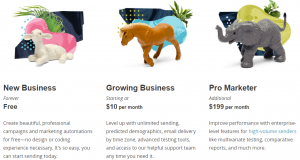Email marketing may seem passe by 2017, but it’s still one of the most effective digital marketing channels to date.
Nearly everyone has an email address, whereas social channels are scattered across different demographics. There are hard, trackable numbers you can associate with email marketing and a ton of different ways to use them, regardless of your business’ focus point.
Here’s a quick overview on using email marketing for a small to medium-sized business.
Determining what you want out of those emails
Email marketing is only truly effective if you have a plan in place and a direction to send people in. For example, your website.
Without a goal in mind, making email campaigns is a challenge. Before you start, you’ll want to decide how email marketing can help your business goals and your marketing goals then let the direction flow from there.
For an e-commerce shop, you may want to make sure emails send people to the store on your site so they convert. If you own a brick and mortar store, you may want to make sure emails send people to your actual store through emails focusing on in-store promotions or events. Within a B2B business, you may want to make sure your emails send people to a “contact us for more information” form or enable them to have a direct conversation.
And this is just for getting started. The sky’s the limit with the different number of campaigns and segments you can have so don’t worry if you have different goals and different things to try – just make sure you focus early on on a few, manageable focus points.
Determine your email marketing tool
There’s a ton of great tools out there. For people new to email marketing, I recommend MailChimp. MailChimp has always had a free option and if you have fewer than 2,000 people on your list and you’re sending fewer than 12,000 messages per month – it stays free.
Other great tools for starting out include Constant Contact, AWeber, MadMimi, MyEmma and Hatchbuck. There are tons of new tools that come up over the years but these have been relatively consistent forces in the email marketing space.
However, MailChimp is always my favorite because it has always honored the lower-tier free plan. They also continuously update the system to be more user-friendly.
Once you get into more complex realms or if you are in e-commerce, however, you want to consider more expensive solutions more tailored to your audience. Fishbowl, for example, is one of the main email marketing programs for restaurant and food-chains. Bronto, on the other hand, works more with larger e-commerce corporations.
Determine your metrics
Some things to note that you can track with email marketing:
- Open rates (what’s the percentage of people opening your email?)
- Click-through rates (what’s the percentage of links that have been clicked?)
- Specific click-throughs (which email address clicked what? Which links were more popular?)
- Subscribes and unsubscribes (who’s signing up and who’s opting out of your list?)
And some things you can’t track with email marketing:
- Replies (there is no easy way to track who replies to an email or how many reply to one – unless the tool you’re using has specific automation features)
- Activity on your website (unless you’re using a marketing automation tool – then you can see what a person does on your site after they click a link in your email or submit a form)
- Precise metrics (since most of the tracking is based on a pixel, people who don’t display any images can throw numbers off. Some mobile inboxes also mess with open rates. Don’t expect surgical precision here)
Enable people to sign up
Make sure there are ways for people to opt-in, either through sign-up forms embedded on your website or a link they can go to directly. You’ll want to get explicit permission, ideally, but it is not required in the US for the CAN SPAM Act of 2003.
SumoMe is a great tool to enable people to sign-up through pop-up modals. There are a ton of other great tools out there but SumoMe’s basic List Builder feature is free.
We do not recommend cheating on this step and purchasing a list. You can read my rant here. List purchasing is the worst and there are no winners on either side of the equation.
Send off that first email!
Make sure you test your email and preview it, click through all of the links, and triple check all of the things but then…let it fly!
It’s terrifying. It doesn’t get any less terrifying when you’re a small business owner sending off an email to a few hundred or a few thousand people. It gets less terrifying when you can delegate the task to an agency or a marketing team member, but then you have to remember that it’s still terrifying for them. 🙂
Emails are easier to send over time, especially once you start creating more segments and more campaigns.
Bonus tip – A/B test
Most any email marketing tool worth its salt these days enables A/B testing or split testing. As early as you feel comfortable with it, start testing. It can be a little daunting but the more data you can gather early on, the better of you’ll be!
